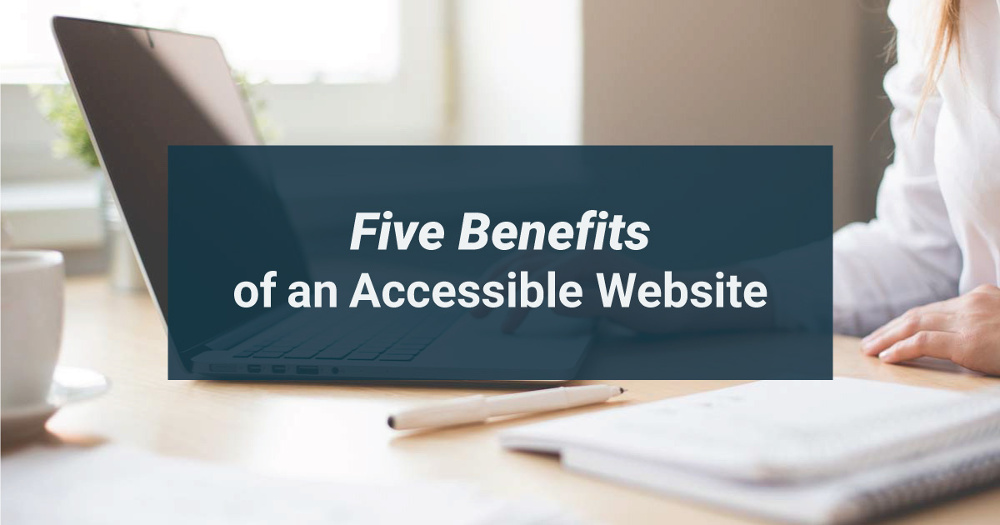In an ideal world, all websites would be 100% accessible. But in reality it’s hard to pull that off—it takes time, money, and expertise to make accesbility updates to your site. To help make the case (whether for you or your boss or a client or whoever else you may need to explain it to), we’ve rounded up five benefits of having an accessible website.
According to w3.org, web accessibility means that websites, tools, and technologies are designed so that people with disabilities can use them. Making a website accessible requires you to follow ADA Compliance standards, and learning the basics will help you understand why it matters.
Of course, the most important reason to make your website accessible is to provide equal access for all, including those who:
- Have visual, hearing, motor, and cognitive impairments
- Use assistive technology, such as screen readers and other devices, to navigate the web
Not only is web accessibility becoming the standard, it has multiple benefits. Here are just five of them.
ADA-compliant websites increase usability, benefiting everyone.
In web terms, “usability” refers to how easy it is for a user to navigate and accomplish tasks on a site. A website with a high level of usability often sees low bounce rates, attracts new and returning users, and increases user satisfaction.
Accessibility and usability go hand in hand; many accessibility requirements are also general usability principles. Designing for accessibility especially benefits people with disabilities, but it also benefits all users by improving the site’s overall ease of use.
Your business may avoid legal trouble.
One of the main reasons that businesses opt for accessible websites is to eliminate the risk of litigation. We are seeing the legitimacy of this risk more frequently—brands such as Netflix, Nike, and Domino’s (to name a few of the big ones) have experienced lawsuits due to a non-compliant digital environment.
According to Section 508, federal agencies and their contractors are required to strictly conform with WCAG Guidelines. If your organization falls under this category, you are at risk for legal trouble if your site does not meet these standards.
Laws surrounding web accessibility for private entities are a little less clear. As the issue of non-compliance is becoming more relevant, we are seeing judges rule in favor of web accessibility falling under the Americans with Disabilities Act. The ADA prohibits discrimination on the basis of disability in places of public accommodation, and websites are increasingly interpreted in legal cases as such.
With this in mind, your business is more likely to receive a demand letter if:
- You have a physical location (restaurant, hotel, bank, gym, museum, etc.)
- Your website consists of commercial activity, e.g. you’re selling products or services or financial transactions are taking place on your site
An accessible digital presence enhances your brand’s image.
Accessibility compliance gives your business an opportunity to demonstrate social responsibility and increase reputation. Taking a stand for accessibility shows your users that your brand supports equal access and opportunity for all. Enhancing your brand’s image fosters a better relationship between your company and its consumers, which can lead to better performance and ROI.
You will likely attract a larger audience.
Most people who do not have direct experience with a disability underestimate the number of people that do. Many people take it for granted, simply because accessibility is not at the forefront of their own lives.
About 61 million people in the US live with a disability, and over half of these individuals access the web regularly. If your site does not allow equal access for all, you are potentially turning away millions of users.
Just as usability and accessibility overlap, so do search engine optimization (SEO) and accessibility. Google ranks accessible websites higher in organic search. This is because accessibility techniques are implemented in metadata, content, and code—all of which affect SEO and help Google rank your site.
Here are just a few of the techniques that also improve SEO:
- Proper page structure
- Alt text for images
- Video transcripts
- Readable copy
You may save money in the future by investing a little more now.
Designing and developing for web accessibility may add an initial upfront cost, but you will likely save money in the future by avoiding legal and redesign expenses. As mentioned above, the importance of web accessibility is becoming more relevant, with rising cases and judges ruling in favor of the ADA. It’s not unlikely that accessibility compliance, and the laws surrounding it, will become stricter in the future.
The benefits of an accessible website are nearly endless. While there are many techniques that you may be able to implement on your own, developing for website accessibility is an involved process that usually requires an expert’s assistance. If you’re curious about the accessibility status of your current site, you can request an audit. We are happy to help you harness these benefits and more.
